Need to move people to action? Wondering how to improve your sales with Facebook ad copy?
In this article, you'll discover how to create Facebook and Instagram ads that generate sales.
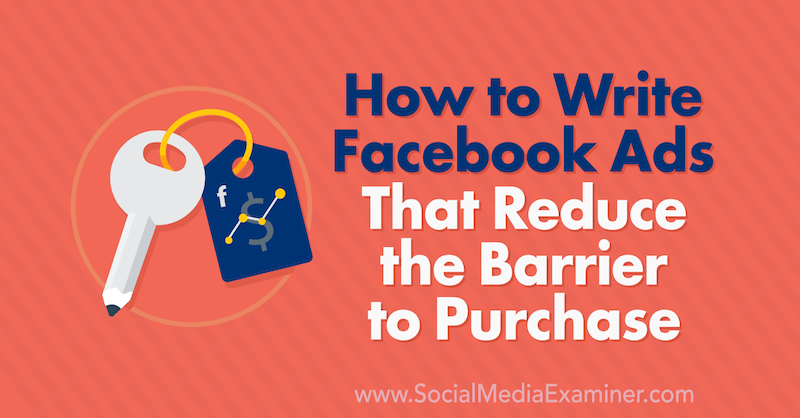
#1: How to Write Discount Ad Copy to Prompt Purchases
Discounts are simple but effective. You've likely seen an ad in your Facebook news feed that says something like, “Get 10% off when you use discount code FB10.”
With new customers, a discount reduces the barrier to entry for your target audience to purchase. It also minimizes the risk associated with purchasing from a new company they haven't used before.
There are several different types of discount offers you can use:
Unconditional discounts: An unconditional discount offer is available to everyone and has no requirements the customer must meet before being able to access the discount. This includes site-wide sales and discounts on specific products.
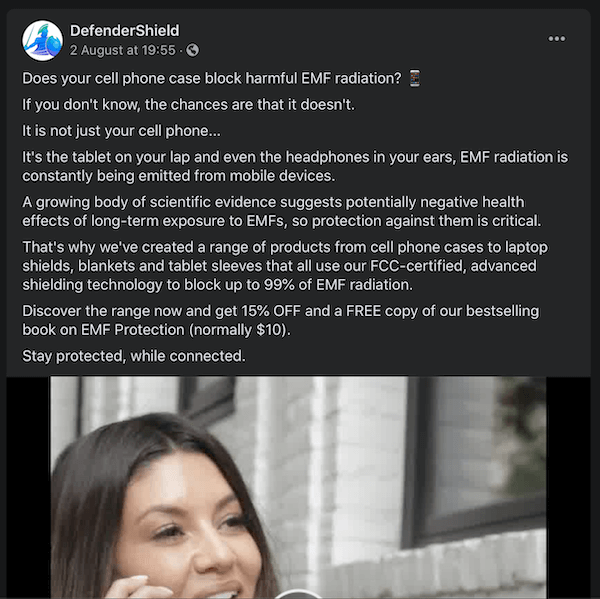
Conditional discounts: A conditional discount is where the consumer must meet a requirement—often in the form of a minimum spend—to be able to access the discount. Examples include a one-off site-wide or product discount, or a tiered discount system such as “10% off when you spend $50, 15% off when you spend $100.”
Flash sales: Flash sales have produced some of the highest returns I've seen. Unlike conditional and unconditional discounts (which you can run as evergreen sales for new customer acquisition), the key to successful flash sales is to run them for no longer than 7 days and only a few times per year. It's the scarcity that massively increases the conversion rate on your website, which decreases your cost of acquisition and improves your return on ad spend.
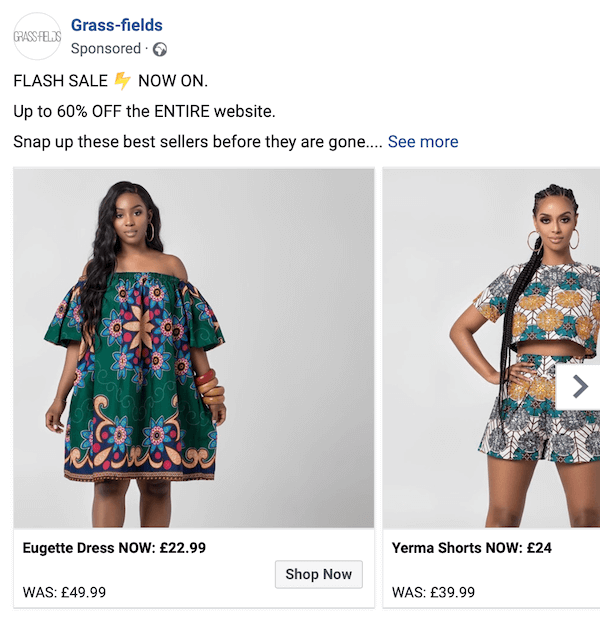
Seasonal sales: Seasonal sales are a no-brainer when relevant to your business. Grounded in brick-and-mortar retail, these sales are proven to convert and generate new purchases quickly. The biggest and most competitive holidays are of course Black Friday and Christmas, but don't forget others such as Easter, Fourth of July, and Halloween.
Shipping and bundle offers: Although you aren't directly positioning a discount in your ads by offering free shipping or “bundle and save,” you're effectively giving people a discount. Similar to conditional and unconditional discounts, free shipping can also be tied to a minimum spend or a specific amount of time.
Amazon set the precedent that free shipping is almost expected, so offering free shipping on your products instead of a product discount can convert extremely well. This is particularly true if you have a low average order value made up of low-priced products. To visualize this, is someone really going to pay $3.99 for shipping when the product they're buying only costs $5.99? Probably not.
Get World-Class Marketing Training — All Year Long!
Are you facing doubt, uncertainty, or overwhelm? The Social Media Marketing Society can help.
Each month, you’ll receive training from trusted marketing experts, covering everything from AI to organic social marketing. When you join, you’ll also get immediate access to:
- A library of 100+ marketing trainings
- A community of like-minded marketers
- Monthly online community meetups
- Relevant news and trends updates
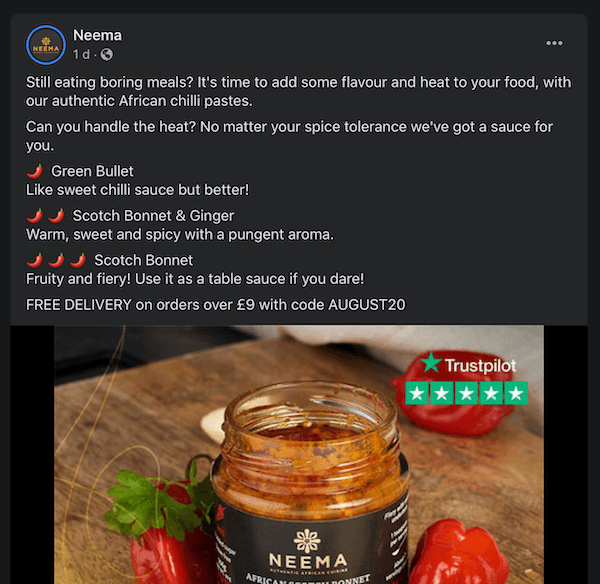
Now that you know the types of discount offers you can use when advertising on Facebook and Instagram, let's look at the structure of a high-converting discount ad.
Discount ad copy can be broken down into three parts: the snap, benefit, and action. The aim is to appeal to the right people in your target audience, get them interested, and then move them to your website to find out more and purchase.
The snap is the attention-grabbing first line of copy. What this line should say depends on what offer you present.
For example, a common snap would be the discount and specific code to use at checkout such as, “Get 20% OFF [your product name] using the discount code FB20.”
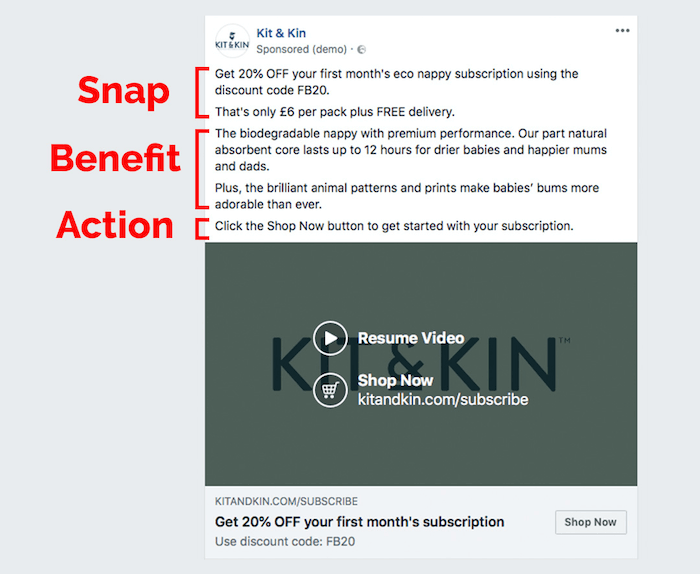
The benefit follows the snap. It lists the core features of your product or service and their benefit to your target audience. For your copy to be effective, you can't just list the features. People want to know how those features will benefit them and impact their lives.
The last part of your copy is the action. This is where you explicitly state the action your target audience needs to take to capitalize on the offer you've positioned in your ad. For eCommerce, that action would be a sentence at the end of your ad copy such as, “Click the Shop Now button to get started.”
The Facebook ad below highlights a different snap that calls out an alternative, more expensive solution to the problem the advertiser's product solves. This tactic immediately pulls in people who are problem- and solution-aware but don't know about the business and their product offering.
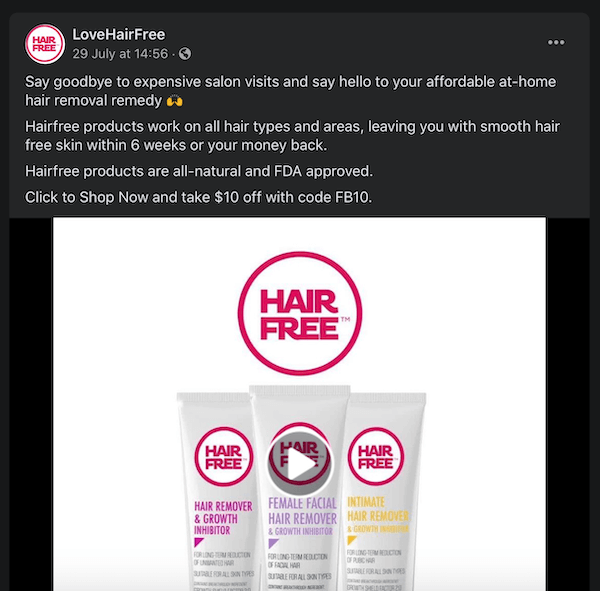
For these types of discount ads, you want to target both cold and warm audiences on Facebook and Instagram.
Target cold audiences (interest-based and lookalike audiences) in “cold purchase test” campaigns, where the aim is to trigger the hyper-responsive people in cold audiences who are ready to buy right away without a lot of consideration time. Use the conversion objective optimizing for purchases and test multiple audiences to discover the most effective ones before you scale your ad spend.
For discount ads targeted at warm audiences, use Facebook page and Instagram profile engagement audiences. Again, like the cold purchase test campaign, use the conversion objective optimizing for purchases. But this time, start by testing a single audience duration such as the last 180 days because this will produce the largest group of people who are still relevant.
Here's a walkthrough of how to create page engagement custom audiences and one for creating lookalike audiences.

Discover Proven Marketing Strategies and Tips
Want to go even deeper with your marketing? Check out the Social Media Marketing Podcast! Publishing weekly since 2012, the Social Media Marketing Podcast helps you navigate the constantly changing marketing jungle, with expert interviews from marketing pros.
But don’t let the name fool you. This show is about a lot more than just social media marketing. With over 600 episodes and millions of downloads each year, this show has been a trusted source for marketers for well over a decade.
#2: How to Write Reminder Ad Copy to Create Urgency
The next type of ad that excels at generating sales is the reminder ad. Reminder ads are as simple as they sound and can be used for website remarketing.
They create urgency by reminding someone of what they've looked at on your website and hooking them into engaging with your ad, revisiting your website, and converting to a customer. You want to use the reach objective, targeting website custom audiences of people who have visited any page on your website in the last 3 days (ideally) or up to a maximum of 10 days.
The shorter the audience duration, the more relevant your ads are and the better the conversion rate. By using the reach objective instead of the conversion objective, Facebook doesn't narrow down an already highly qualified audience—your website traffic.
The key to creating an engaging reminder ad, like any ad, is the snap. The first line in the ad copy needs to grab your target audience's attention and immediately convey that the ad is for them. A statement that reiterates they've previously browsed your website can be effective, as you can see in the Facebook ad below.
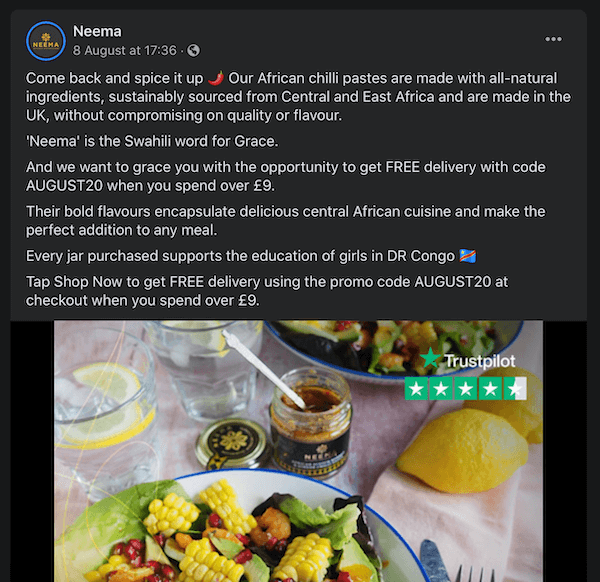
For the rest of the copy, repeat any discount offer they may have seen on your website or from Facebook ads further up your ad funnel, such as the discount mentioned in your cold purchase test campaign or warm audience remarketing campaign.
To illustrate, repeat a conditional discount and the relevant code they need to use to redeem it such as, “10% OFF when you spend over $50 using the code FB10 at checkout.” Follow this with a call to action (CTA) to drive people to the product page for what you're offering in the ad.
In addition to your ad copy, include the discount offer in your creative and/or headline or news feed link description.
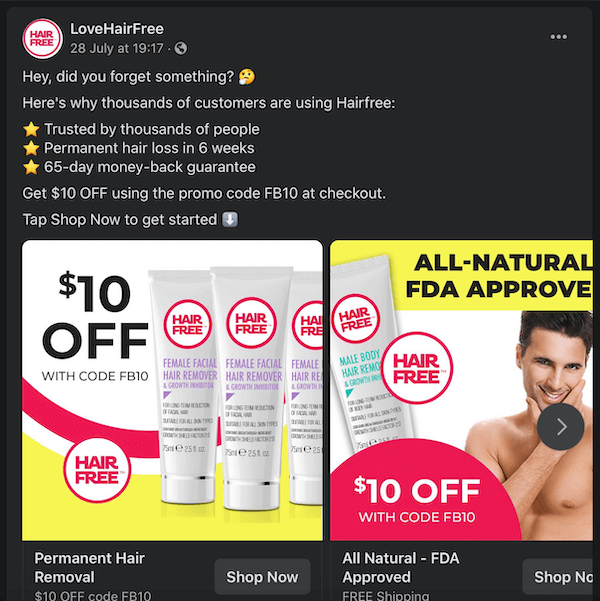
No ad format is more effective than another for this type of Facebook ad campaign. I've seen success with the single image, video, and carousel ad formats.
#3: How to Write Testimonial Ads That Build Trust
The final type of ad that generates sales extremely well is the testimonial ad. The goal is to build trust through social proof in the form of a customer review or testimonial. Similar to reminder ads, testimonial ads are best used in website remarketing campaigns, targeting people who have visited your website but not purchased.
One of the most common questions I get asked about testimonial ads is, “Should I format the testimonial as video or text?”
I typically start with text-based ads because they're the easiest to source and most businesses already have them. In recent testing, I've found that text-based testimonial ads outperform video testimonial ads, but the reverse may be true for some niches. You can start with text-based ads to see how they perform. If you do have video testimonials, it's also worth testing their effectiveness.
When creating text-based testimonial ads, use the following ad copy structure.
Start with your testimonial. If you have a long, wordy testimonial, shorten it or divide it into multiple paragraphs so it's not a single block of text. Use quotation marks so the testimonial is different from the rest of your ad copy and end it with a hyphen followed by the customer who wrote it.
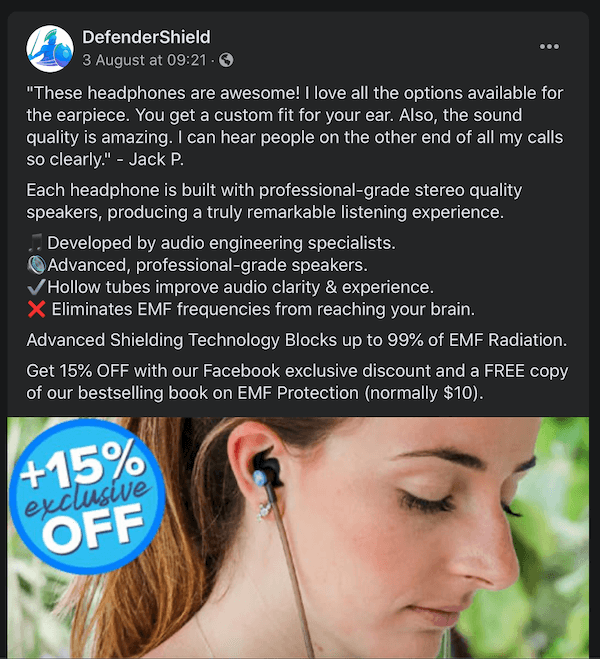
The second part of the testimonial ad copy is your product or service promotion. This is identical to a reminder ad. So for instance, repeat a discount offer that the people in your website custom audience have seen on your website or that you've promoted to them through your cold purchase test campaigns or warm audience engagement remarketing campaigns.
The final part of your testimonial ad copy is the CTA. Because these are direct-response ads and you want the people who see them to take action, the last part of the ad copy should get the consumer to click on the ad and convert to a customer.
The Facebook ad below shows the offer after the testimonial, followed by the CTA to drive clicks on the ad and direct people to the relevant product page.
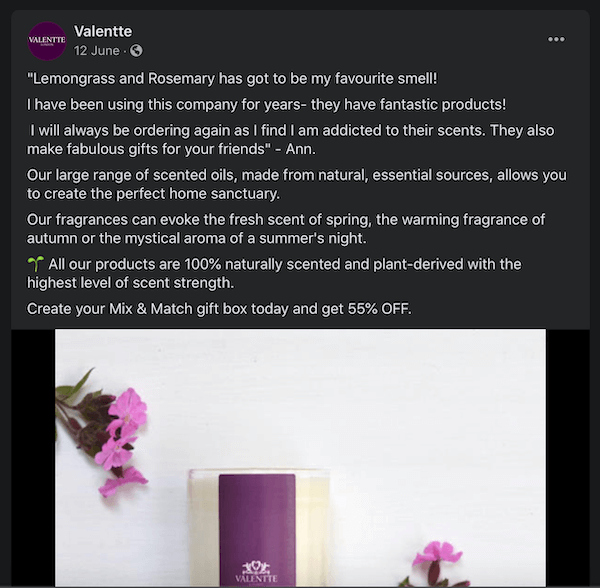
For the creative in a text-based testimonial ad, choose something relevant to the product or service you're promoting. Lifestyle product images and videos can work well.
Conclusion
These three ad types can help you sell your products or services across the range of audience temperatures—cold, warm, and hot—on Facebook and Instagram. For example, run reminder or testimonial ads to your website visitors and discount ads to people who don't know your business yet or those who have engaged with your page on Facebook or Instagram.
The key to generating consistent results month after month with Facebook and Instagram advertising isn't to rely on only one type of campaign in which these ads sit. If you just focus on website remarketing, you'll burn out your audiences if you aren't directly driving new people to your site. Or if you only focus on cold purchase test campaigns, you're leaving money on the table by not showing ads to people who have visited your website.
You want to create Facebook and Instagram campaigns using these ad types that target all three audience temperatures. That way, people move from one campaign to the next until they become a customer.
What do you think? Which of these ad types do you use in your Facebook and Instagram campaigns? Share your thoughts in the comments below.
More articles on Facebook marketing:
- Discover how to set up Facebook Shops to sell your products.
- Learn how to develop Facebook audiences for cold, warm, and hot prospect targeting.
- Find out how to use Facebook ads to generate sales and leads quickly.
Attention Agency Owners, Brand Marketers, and Consultants

Introducing the Marketing Agency Show–our newest podcast designed to explore the struggles of agency marketers.
Join show host and agency owner, Brooke Sellas, as she interviews agency marketers and digs deep into their biggest challenges. Explore topics like navigating rough economic times, leveraging AI, service diversification, client acquisition, and much more.
Just pull up your favorite podcast app, search for Marketing Agency Show and start listening. Or click the button below for more information.

